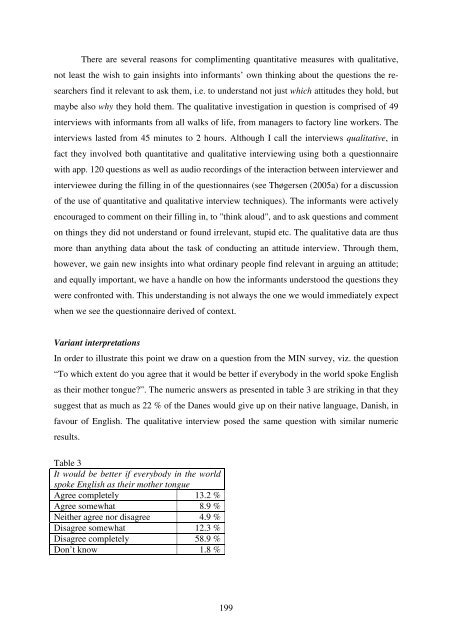Hør dog hvad de siger - Note-to-Self: Trials & Errors
Hør dog hvad de siger - Note-to-Self: Trials & Errors
Hør dog hvad de siger - Note-to-Self: Trials & Errors
You also want an ePaper? Increase the reach of your titles
YUMPU automatically turns print PDFs into web optimized ePapers that Google loves.
There are several reasons for complimenting quantitative measures with qualitative,<br />
not least the wish <strong>to</strong> gain insights in<strong>to</strong> informants’ own thinking about the questions the re-<br />
searchers find it relevant <strong>to</strong> ask them, i.e. <strong>to</strong> un<strong>de</strong>rstand not just which attitu<strong>de</strong>s they hold, but<br />
maybe also why they hold them. The qualitative investigation in question is comprised of 49<br />
interviews with informants from all walks of life, from managers <strong>to</strong> fac<strong>to</strong>ry line workers. The<br />
interviews lasted from 45 minutes <strong>to</strong> 2 hours. Although I call the interviews qualitative, in<br />
fact they involved both quantitative and qualitative interviewing using both a questionnaire<br />
with app. 120 questions as well as audio recordings of the interaction between interviewer and<br />
interviewee during the filling in of the questionnaires (see Thøgersen (2005a) for a discussion<br />
of the use of quantitative and qualitative interview techniques). The informants were actively<br />
encouraged <strong>to</strong> comment on their filling in, <strong>to</strong> "think aloud", and <strong>to</strong> ask questions and comment<br />
on things they did not un<strong>de</strong>rstand or found irrelevant, stupid etc. The qualitative data are thus<br />
more than anything data about the task of conducting an attitu<strong>de</strong> interview. Through them,<br />
however, we gain new insights in<strong>to</strong> what ordinary people find relevant in arguing an attitu<strong>de</strong>;<br />
and equally important, we have a handle on how the informants un<strong>de</strong>rs<strong>to</strong>od the questions they<br />
were confronted with. This un<strong>de</strong>rstanding is not always the one we would immediately expect<br />
when we see the questionnaire <strong>de</strong>rived of context.<br />
Variant interpretations<br />
In or<strong>de</strong>r <strong>to</strong> illustrate this point we draw on a question from the MIN survey, viz. the question<br />
“To which extent do you agree that it would be better if everybody in the world spoke English<br />
as their mother <strong>to</strong>ngue?”. The numeric answers as presented in table 3 are striking in that they<br />
suggest that as much as 22 % of the Danes would give up on their native language, Danish, in<br />
favour of English. The qualitative interview posed the same question with similar numeric<br />
results.<br />
Table 3<br />
It would be better if everybody in the world<br />
spoke English as their mother <strong>to</strong>ngue<br />
Agree completely 13.2 %<br />
Agree somewhat 8.9 %<br />
Neither agree nor disagree 4.9 %<br />
Disagree somewhat 12.3 %<br />
Disagree completely 58.9 %<br />
Don’t know 1.8 %<br />
199



